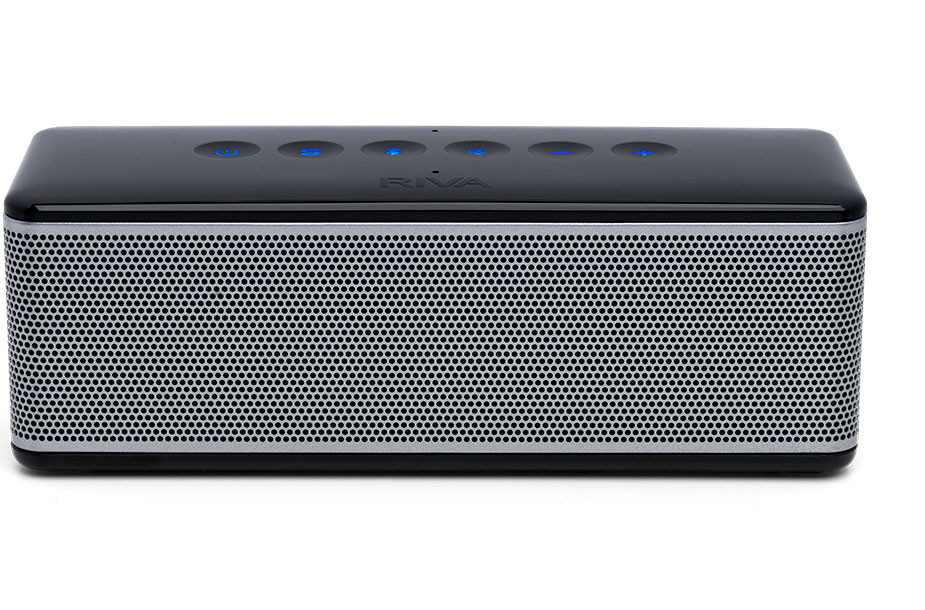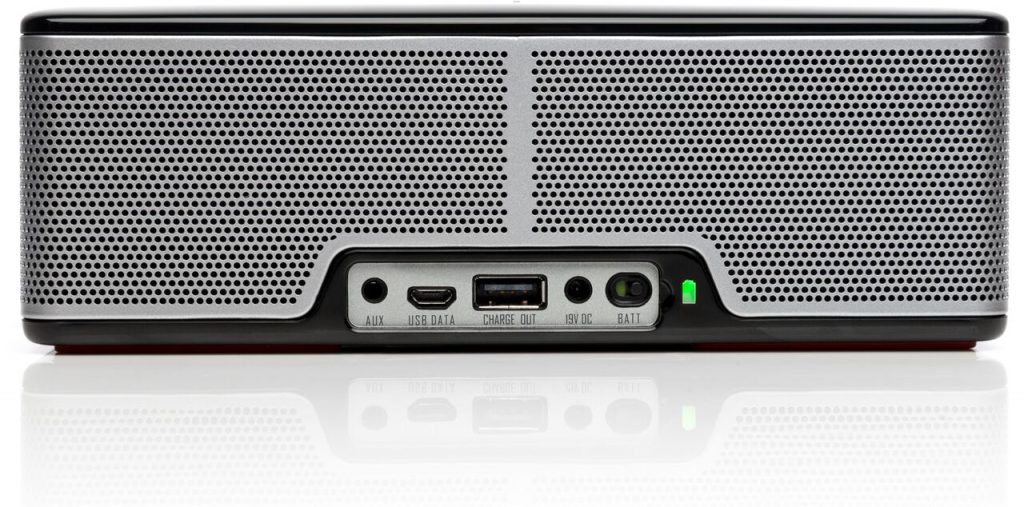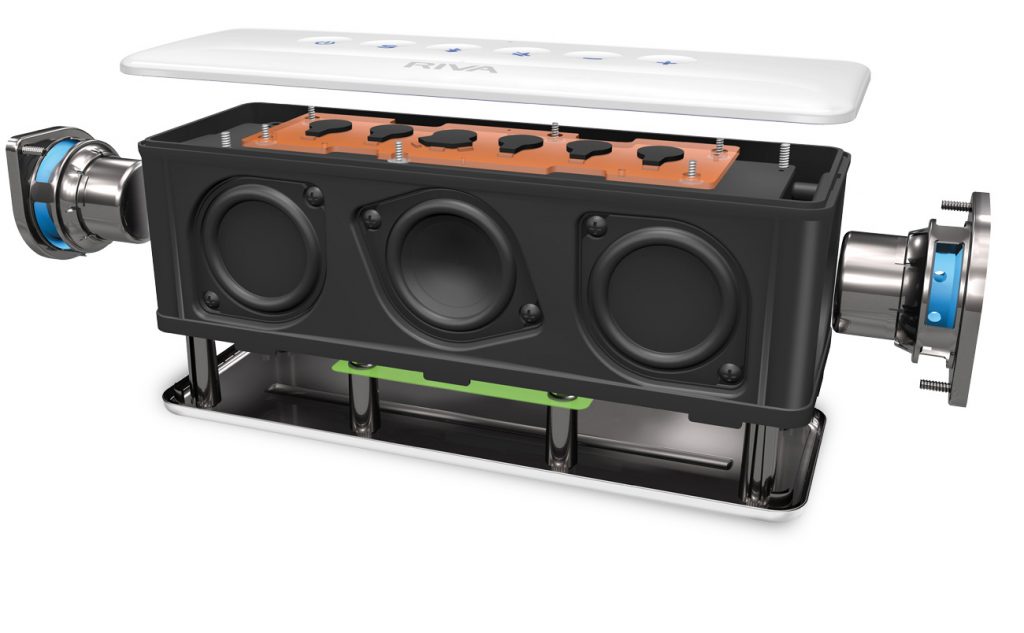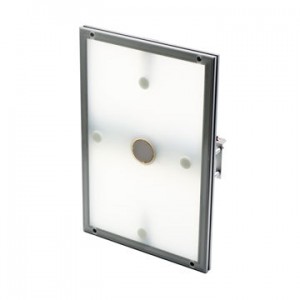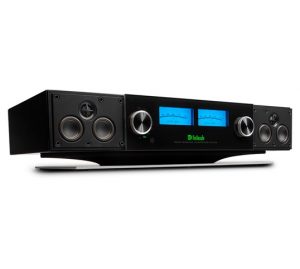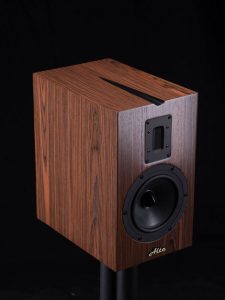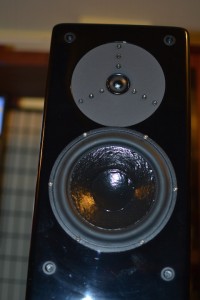"Hey, check this out," Dave said as he pulled a sleek silver and black gizmo from a sturdy little nylon sleeve. "It's a RIVA portable speaker," he said, tapping a glowing touch-button. A rich, whirly arpeggio emanated with a surprising bit of rumble to it. He rattled off some technical-sounding descriptions that were over my head, but I was on the way out the door, and even if I'd understood them I probably wouldn't remember them now anyway.
"Here, take 'em with you and see what you think," as a second matching gizmo appeared and was handed to me. I was hesitant—I mean, what the heck do I know about audio gear? I love my music listening as much as anyone, but I'm not techie. On the other hand, I definitely know what I like when I hear it (and when I don't) so I said, "Sure!" and off I skipped with a matching pair of RIVA S portable Bluetooth speakers and a sense of audio adventure…
When I got home I slipped one of the speakers out of its case and took a closer look. For starters, I loved that little case. It seemed singularly adequate for the job of protecting a speaker you'd want to take places. It's rugged, it's reasonably padded, it has a carabiner for securing it to stuff, and there's a handy grab loop to boot. All in all I'd feel comfortable tossing the RIVA S in its nylon cocoon into a travel bag or the back seat of my car for a trip to the beach without much worry. I was surprised that this case is standard issue and not an available twenty-five dollar accessory, too. It seems the folks at RIVA actually imagined the life of their product out in the real world, and happily decided to give you what you're sure to want anyway. What an excellent start!
The RIVA S slipped into my hand with a satisfying heft. I won't say it's a heavy speaker, coming in at 1.5 pounds, but the mass it does have seems reassuring—like it's packin' something serious in there to make my ears happy. Same goes for its size that seems just about right: small enough to be unobtrusive but present enough that it doesn't look like an afterthought sitting on a shelf (or a patio table, or…) Speaking of looks, the glossy black plastic and wraparound silver metallic grill on the RIVA S are a reasonably handsome presentation, and together with its row of six scalloped, capacitive touch controls on top that glow blue at the wave of a hand the overall look is fairly minimalist and elegant.
The way I figure it, hassle-free connectivity is pretty much a minimum requirement in today's wireless-filled, plug-and-play world. With one RIVA S I wasn't disappointed—getting hooked up was a smooth and reliable procedure. Two RIVA S's linked together with RIVA's TrueWireless technology occasionally led to some frustration however. It's all about the sequence, you see—get it right and all's well. A small handful of times times though I ended up stuck in some kind of demented loop, toggling repeatedly between speaker connections, my source device connection, and "pairing mode" before things worked out.
When I finally heard the RIVA S, I realized immediately how many subtle expectations I'd harbored about small portable speakers. They have harsh or tinny highs, muddied middles, or weak lows. They sound squashy, compressed, overdriven to get the sound out. They're directionally challenged. These drawbacks came to mind so clearly because with the RIVA S, they were—all of them—conspicuously absent.
The RIVA S sound is wide. It's deep. It's amazingly consistent across the tonal spectrum. The sound is, above all, balanced, with everything seemingly in its place. An entirely tasteful and rich listening experience, and one I was truly surprised to be hearing.
A lot of credit for what the RIVA S can do seems related to its patented ADX Trillium Audio Technology. The RIVA S splits a stereo signal into three parts, and delivers them via active drivers facing front, right and left—as in, pointing right out the ends of the unit. That means you've always got some of that sound delivery facing away from you, which seems like a weird idea, but somehow instead of feeling like you're off to the side, everything works together well enough that the effect is of always being right in the sweet spot—a slightly magical pan-directional kind of thing when it's all said and done. I felt the music in the room, as opposed to from the speakers. (Incidentally, three channels allows for a simulated surround setting in case you want to try for an even wider and deeper sonic field, but I found its effectiveness varied greatly across recordings and genres.)
In addition to the three active drivers, RIVA has slipped in four more passive radiators (two facing front, two facing the rear), and I suspect they have a lot to do with how the RIVA S spreads it sound out so effectively without sacrificing tonal quality (not to mention that sneaky ability to deliver a decent thump.) Picturing all seven of those vibrating components inside the RIVA S pitching in makes it more conceivable to me that you get so much space for listening. From the body-slapping twang of funk bass to overtones derived from tight vocal harmony arrangements, the individual characteristics of each instrument and musical line always had room to shine, clearly and precisely. That killer balance though, meant that no part ever lost its connection to the sonic whole, either.
It's gotta be tough to tune a thing like the RIVA S. How do you get a single unit to sound good in the living room, the kitchen, and at the beach? I have no idea, but apparently RIVA does. With no EQ or tone settings to tweak you're stuck with what you get, but I almost always felt that I wouldn't have changed much if I could. There were a few moments early on when I felt the sound was skewed just a bit rich, a fraction bassy for the smaller rooms in my house. If that bias exists however, it's slight, and maybe it's the overarching characteristic of sonic openness that lets the RIVA S get away with it—it never interfered with my ability to dive into the music. (You may find that your favorite podcasters or NPR reporters have slightly deeper voices than you remember however.)
If you've got to try and make your speaker work everywhere though, I realized right away this was the way to do it when I first cranked up the RIVA S outside. Nowhere does this product sound better than in my backyard, and I suspect that extra touch of goodness down low helped to keep things from getting swallowed up in the great outdoors. It's more like the RIVA S loves having the extra air to play with in fact, and it managed to send happy strains to my ears across an impressive distance—a good fifteen paces before things started to sound a little distant at full volume. Bass drum still thumping, breathy vocals still airy and direct.
Overall the RIVA S manages to be a bigger, fuller, and more satisfying sound than I ever would have thought possible from a single, small portable speaker—but there is one thing you can do to enhance the experience: buy another one. Connecting two RIVA S speakers via RIVA's TrueWireless mode delivers an acoustic package that is greater than the sum of its parts. Not surprisingly, stereo listening takes on a new dimension in this configuration (the units switch from the Trillium profile to dedicated left/right roles), and there's significantly more overall oomph when you double down.
From the quality of its case, to its looks, to its sound and tuning, I get the impression that the team at RIVA is a careful and thoughtful bunch. The RIVA S's bells and whistles don't dissuade that view. My favorite is a rubber stopper stored underneath the unit that covers its vulnerable ports to enhance its "splash resistance." The ports it protects are: 3.5mm, USB data, USB for charging an external device, and 19v DC for charging. There's a cool phono mode by the way that'll add up to 9dB of gain to compensate for your turntable's weaker signal. Party Mode allows multi-user control so you and your friends can swap DJ duties on the fly, and if you need to take a call the RIVA S has a speakerphone mode. All pretty neat and useful features. The only one I didn't really care for was the available app, which felt mostly superfluous to me, and a bit clunky besides. I ditched it after ten minutes without regret.
At the end of the day, the RIVA S may not replace the full-sized setup in your living room. But it's a mistake to think of this speaker as just a way to add mobility to your musical library. It's a high-quality listening experience in its own right that seems too good to be lumped into any existing category defined primarily by portability. If you're an audiophile who's been waiting for the right technology to come along before making the jump into a great-sounding speaker that you happen to be able to take with you, now is the time.
RIVA S
Retail: $249
RIVA Audio




